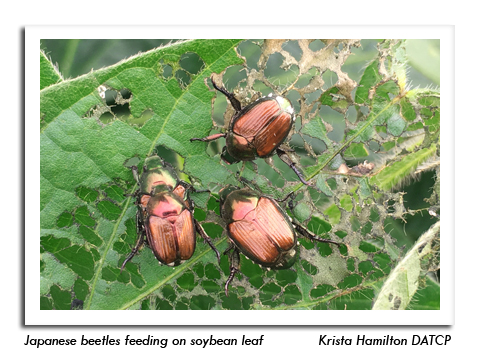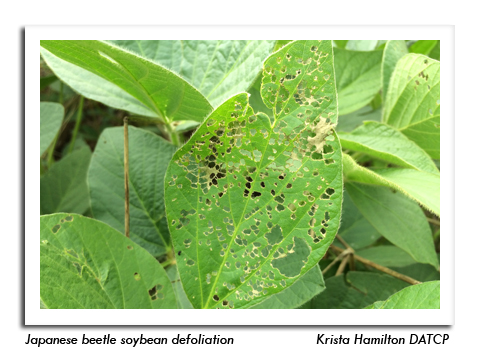
 |
|
|
Soybeans
Volume 64 Number 15 Date 08/08/2019 GREEN CLOVERWORM - Larvae of all sizes are common in soybeans, particularly in fields from the west-central to the northwest areas of the state. This week's highest counts of 20-30 caterpillars per 100 sweeps were found in Jackson, La Crosse and Trempealeau counties. The majority of larvae observed were newly hatched and still relatively small, suggesting that feeding injury will likely intensify by mid-August. Based on recent survey observations, populations and defoliation could be locally high this season. SOYBEAN APHID - Surveys conducted during the two-week period from July 25-August 7 found no economic populations in 101 sampled fields. Densities were very low (<10 aphids per plant) at the majority of sites, with only two fields in Chippewa and Washburn counties having averages of 20-35 aphids per plant. Although surveys indicate populations are low, aphid pressure usually intensifies this time of year, and some fields may still require treatment in the next 1-2 weeks. Soybean producers are reminded that control is not advised until the economic threshold of 250 aphids per plant on 80% of the plants throughout the field has been exceeded. Once again, field-wide average counts have not surpassed this level in any soybean field surveyed by DATCP this season. All soybeans should be examined next week to evaluate aphid densities. JAPANESE BEETLE - Defoliation is prevalent again this year. Japanese beetles are causing variable damage to soybean field margins, with the highest counts (40-184 beetles per 100 sweeps) documented in Eau Claire, Grant, Sauk and Trempealeau counties in the southwest and west-central districts. Average defoliation rates in fields surveyed since late July have been below the 20% threshold for soybeans in the reproductive stages, therefore treatment has generally not been warranted. -- Krista Hamilton, DATCP Entomologist 



|
|
|